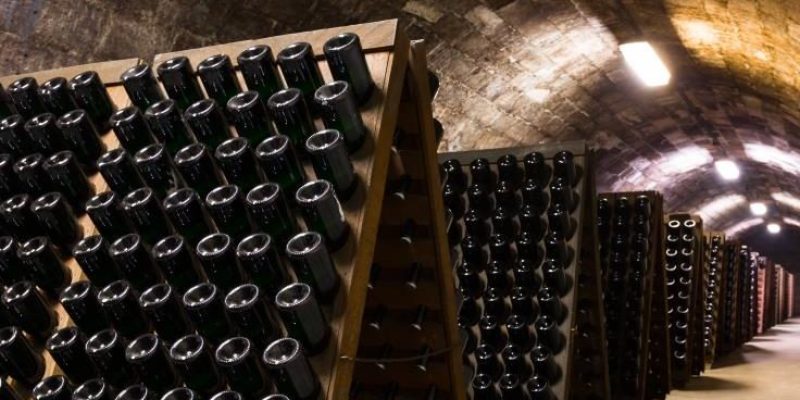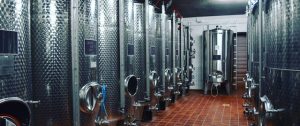We left our Making Champagne miniseries just after adding the liqueur de tirage (yeast and sugar) before we sent the bottles to the cellars.
In Part III, we’ll see more geeky science stuff and more fancy French words for ageing champagne. We’ll cover all the cool stuff that happens in the dark, musty underground cellars to turn still wine into beautiful, bubbly champagne!
To set the scene inside a champagne cellar… imagine inside Mumm’s cellars, there are nearly 25 million bottles of champagne. The cellars, which are carved out of chalk, measure 25km in length and took 70 years to excavate.
Let’s step down inside the cellars for ageing the champagne.
Champagne ageing (or secondary fermentation)
The next step in making champagne is ageing or secondary fermentation.
Secondary fermentation is kicked off by the the tirage of yeast and sugar that’s added right before bottling. In a process called prise de mousse which I have seen translated as ‘foam creation’ but I like the Comité Champagne’s translation as ‘capturing the sparkle’ (how lovely!), still wine becomes sparkling.
What happens during prise de mousse is the yeast we added consumes the sugar, converting it to alcohol (yay for that!) and carbon dioxide. The CO2 gas can’t escape from the bottle so it produces the bubbles throughout the wine. So obviously what this means is… we now have (finally!)… champagne!
The prise de mousse takes about 3-4 months, and once the yeast has converted all the sugar, you are left with the sparkling wine but you’ve also still got the yeast cells (called lees) in the bottle. The yeast/lees play an important part in the next step in ageing champagne… autolysis.
Autolysis
Have you ever heard a smarty-pants talk about how long champagne has been “on lees”? What they are actually talking about is how long the bottles are aged. Time on lees is the time the bottles are left untouched in the cellars, after the prise de mousse is finished but while the lees (yeast cells) still sit in the wine.
Champagnes sit on lees for many years. There are strict regulations on the minimum time champagne must be aged on lees…
- Any non-vintage bottle of champagne must still spend at least 15 months maturing in the cellars. You will find most houses will cellar theirs NVs for 2-3 years.
- Vintage champagnes must spend a minimum of 3 years ageing… again most houses will exceed this minimum for the good of the champagne, generally between 5 and 8 years for vintages and cuvee de prestige champagnes may be aged as long as 10 years.
It’s during this time on lees that the important process called autolysis occurs. Autolysis literally means cell destruction by its own enzymes.
During autolysis in ageing champagne, it is the yeast cells that are (slowly) broken down.
So that is what happens, but what it means is while the wine is in contact with the lees and autolysis is happening, the yeast cells impart flavour and complexity to the wine, refines the bubble size, and reduces the need for adding as much sulphur dioxide to preserve the wines.
Riddling or remuage
So now we know why we want autolysis as part of ageing champagne but all this talk of dead yeast cells is a bit rough. They’re still sitting in our champs and who wants to drink wine with dead yeast sediment in it? Not me!
Luckily, the clever French champagne cellar masters have a solution… another of my favorite enigmatic and romantic elements of making champagne – riddling or remuage. Which was in fact invented by La Grande Dame of Champagne, Madame Barbe-Nicole Clicquot. Madame Clicquot who was widowed at 27 gave her name to the house Veuve Clicquot (veuve is French for widow).
What riddling does is it loosens the yeast sediment and causes it to collect in the neck of the bottle. This makes it easy to remove during disgorgement (that’s coming next) leaving our champagne bubbly and clear.
Riddling is an ancient technique where the bottle is delicately, gradually, and incrementally rotated (1/4 or 1/8th of a turn at a time) and simultaneously tilted neck down (sur pointe in French). Turning the bottle clock-wise and anti-clockwise loosens the sediment and tilting it neck down moves the sediment to the neck making it easy to remove.
Traditionally riddling was always done manually by a remueur (bottle turner) using a wooden “pupitre” or a-frame. Manual riddling takes 4-5 weeks and involves about 25 turns per bottle. A very talented remueur will turn 40,000 bottles a day… How remarkable!
Many houses now employ automated remuage using a machine-based gyropalette that works on turning and tilting 500 bottles at a time. This will take about a week in total and has no effect on quality… just on the romance of riddling racks and lovingly hand-turned bottles.
That said, every bottle of champagne from the house of Pol Roger still undergoes manual remuage.
Disgorgement
Now the sediment is loosened and is sitting in the neck of the bottles from the riddling, your champagne is finally ready for disgorgement. Disgorging sees the sediment “ejected” from the bottle, and your champs is very nearly ready to be shipped and poured into your glass!
There are two main ways to disgorge…. by hand or mechanically.
During mechanical disgorgement the neck of the bottle is plunged into a freezing solution at -27 degrees Celsius locking the sediment in a frozen “plug” which is easily ejected when the bottle is opened.
Hand disgorgement (“a la volee”) is reserved for certain special cuvees…. holding the bottle upside down, it is quickly opened and titled back upright so that only the top section of the champagne containing the sediment is released.
Liqueur d’expédition
Right after disgorgement your champagne is topped up with the ‘liqueur d’expédition’, a mix of cane sugar and wine. The mix will vary according to the style of Champagne and is the final touch and blending. The wine that is added in may be the same as what is already in the bottle or it may be a reserve wine. The wine makers will start trying different wines in the mix a few months before disgorgement to select the final, ultimate blend that perfectly compliments or finishes the champagne.
We are so close now!!!! Stick with me for ONE more step….
Final corking, poignettage, and mirage
Don’t you just love the French language?
As soon as the liqueur d’expédition is in, the cork is added to the neck of the bottle. The cork (marked with the name of the Champagne Appellation and the vintage for vintage wines) is literally forced under pressure into the bottle, the branded metal cap is added, and – even under pressure from the bubbles – it is all held in place by the muselet (wire cage).
Then comes poignettage… which is vigorous shaking so the dosage mixes with the rest of the wine… and mirage – one last inspection of the bottle before it heads back to the cellar for a final few months before release.
And then, finally, after at least two years but usually more than three years or as long as 10 glorious years in the making, the magnificent bottle of champagne makes it way to you.
Enjoy, respect, appreciate, savour and revel in all the effort, love (and science) that take the grapes from the vine to create your champagne.
La fin
(THE END)












